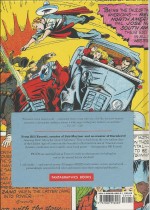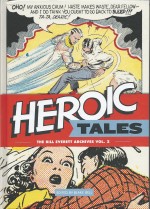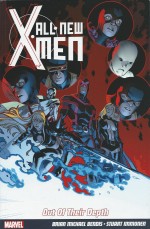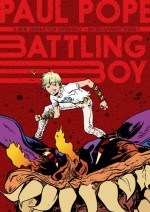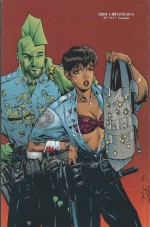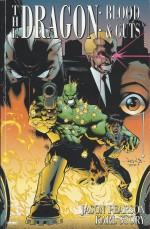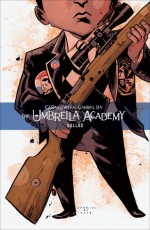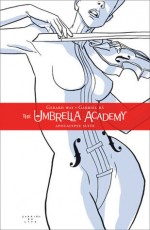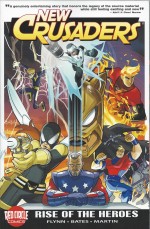
By Ian Flynn, Ben Bates, Alitha Martinez & Gary Martin (Archie Comics)
ISBN: 978-1-936975-31-0
In the dawning days of the comic book business, just after Superman and Batman had ushered in a new genre of storytelling, many publishers jumped onto the bandwagon and made their own bids for cash and glory. Many thrived and many more didn’t, relished only as trivia by sad old blokes like me. Some few made it to an amorphous middle-ground: not forgotten, but certainly not household names either…
MLJ were one of the quickest publishers to jump on the mystery-man bandwagon, following the spectacular successes of the Man of Tomorrow with their own small but inspirational pantheon of gaudily clad crusaders, beginning in November 1939 with Blue Ribbon Comics, soon followed by Top-Notch and Pep Comics. The content was the standard blend of two-fisted adventure strips, prose pieces and gag panels and, from #2 on, costumed heroes…
However, after only a few years Maurice Coyne, Louis Silberkleit and John Goldwater (hence MLJ) spotted a gap in the blossoming market and in December 1941 nudged aside their masked heroes and action strips to make room for a far less imposing hero; an “average teen†who would have ordinary adventures like the readers, but with triumphs, romance and slapstick emphasised.
Pep Comics #22 featured a gap-toothed, freckle-faced, red-headed goof who clearly took his lead from the popular Andy Hardy matinee movies starring Mickey Rooney. Goldwater developed the concept of a youthful everyman protagonist, tasking writer Vic Bloom and artist Bob Montana with the job of making it work. The 6-page tale introduced Archie Andrews and pretty girl-next-door Betty Cooper as well as his unconventional best friend and confidante Jughead Jones in their small-town utopia of Riverdale.
The feature was an instant hit and by the winter of 1942 had won its own title. Archie Comics #1 was the company’s first solo-star magazine and with it began the gradual transformation of the entire company. With the introduction of rich, raven-haired Veronica Lodge, all the pieces were in play for the comicbook industry’s second Genuine Phenomenon (Superman being the first)…
By 1946 the kids had taken over, so MLJ renamed itself Archie Comics; retiring its heroic characters years before the end of the Golden Age and becoming, to all intents and purposes, a publisher of family comedies. Its success, like Superman’s, changed the content of every other publisher’s titles, and led to a multi-media industry including TV shows, movies, and a chain of restaurants. In the swinging sixties the pop hit “Sugar, Sugar†(a tune from their animated show) became a global smash: their wholesome garage band The Archies has been a fixture of the comics ever since.
Nonetheless the company had by this stage blazed through a rather impressive pantheon of mystery-men who would form the backbone of numerous future superhero revivals, most notably in the High-Camp/Marvel Explosion/Batman TV show-frenzied mid-60’s…
The heroes impressively resurfaced in the 1980s under the company’s Red Circle imprint but again failed to catch the public’s attention and Archie let them lie fallow (except for occasional revivals and intermittent guest-shots in regular Archie titles) until 1991, when the company licensed its heroes to superhero specialists DC for a magically fun, all-ages iteration (and where’s that star-studded trade paperback collection, huh?!).
Impact Comics was a vibrant, engaging and fun all-ages rethink that really should have been a huge hit but was again cruelly unsuccessful…
When the line folded in 1993 the characters returned to limbo until DC had one more crack at them in 2008, trying to incorporate the Mighty Crusaders & Co into their own maturely angst-ridden and stridently dark continuity – with the usual overwhelming lack of success.
Now at last the wanderers have returned home to Archie for a superbly simplistic and winningly straightforward revival aimed squarely at old nostalgics and young kids reared on highly charged action/adventure cartoon shows: brimming with all the exuberant verve and wide-eyed honest ingenuity you’d expect from an outfit which has been pleasing kids for nearly seventy years.
Released initially online in May 2012 – and followed by a traditional monthly print version that September – the first story-arc even made it to full legitimacy in this thrill-packed collection, equally welcoming to inveterate fanboys and eager newcomers alike.
The first 6 issues collected here offer grand old-fashioned Costumed Drama and modern teen-targeted Fights ‘n’ Tights action that begins with the 2-part introduction ‘From the Ashes’ by Ian Flynn, Ben Bates & Gary Martin.
Red Circle is an idyllic, storybook American town – now. That wasn’t always the case however, and as Mayor Jack Sterling hosts a party for some very old friends and their kids in ‘Reunions’, that dark past horrifically resurfaces as the festivities are cancelled due to a murderous attack by a manic super-villain.
One minute Ralph Hardy, John Dickering and wife Thelma, John and Rose Raymond, Ted Tyler and Kim Brand are watching their respective teenagers mooching about and not getting along and the next they’re all dead at the hands of alien overlord the Brain Emperor…
Only late arriving Joe Higgins is left to shepherd the kids from the burning Mayoral mansion, operating under a long-practised escape plan devised by the heroic Mighty Crusaders…
Debuting way back when in Pep Comics #1, January 1940, Higgins was an FBI scientist who devised a suit which gave him enhanced strength, speed and durability, battling the USA’s enemies as The Shield in the days before America entered WW II. He also devised a serum which enhanced those powers, smashing spies, saboteurs, subversives and every threat to Democracy and well-being. A minor sensation, he is credited as comics’ first Patriotic Hero, predating Captain America and Quality’s Uncle Sam in “wearing the Flagâ€.
In the sixties he and many of his lost cohorts returned to battle crime and craziness once more…
After accomplishing the impossible and wiping out super-crime he, Steel Sterling, Jaguar, Comet, The Web, Pow-Girl, Fireball and Fly Girl happily retired from action. Unable to settle or relax, Higgins became a virtual recluse and, as Evil Never Dies, laid contingency plans with his old comrades.
Now with all his nightmares come true, he sequesters the traumatised kids in his high-tech bunker and relates the truth about the seemingly dull-and-boring dearly departed in ‘Birthrights’.
The Red Circle tragedy is covered up by Federal spooks from the Military Logistics & Jurisdiction Bureau and dubbed a freak storm on the Impact City news, but orphans Johnny Sterling, Alex Tyler, Greg Dickering, Kelly Brand, Wyatt Raymond and Hardy’s young apprentice Ivette Velez know the truth. They just can’t come to grips with it.
Once Old Man Higgins had saved them from the monster-maniac, he locked them up in his subterranean wonderland – with the full approval of the MLJ – and started talking nonsense.
He claimed their folks were the world’s greatest superheroes and expects them to take up their identities and mission. It’s crazy and totally impossible to believe, but he has all kinds of evidence and gadgets in his bunker. There’s even a mutant talking monkey named Dusty, and somehow he makes more sense than his snarky, impatient boss…
It’s too much and the kids rebel, so Higgins lets them go. All they have to do is get out of the bunker alive…
The terrifying gauntlet proves to the shell-shocked teens that they are far from average and they elect to stay. ‘Legacies part 1: Growing Pains’ then describes the mandatory training process wherein the neophytes, through determination, pre-prepared inheritances, sheer dumb luck and rash stupidity become a second generation of heroes, privy to all the secrets and responsibilities of a world hidden from most of humanity.
Kelly is dispatched by Dusty (or Dr. Uruk Ak’ahk to give him his proper title) to a trans-dimensional space station operated by veteran Crusader Bob Phantom to pick up the alien gimmicks which will make her the new Fly Girl, whilst timid low-esteem-plagued Ivette is given the magical Jaguar Helmet of Ai Apaec, discovered by her boss Ralph Hardy and intended for her alone. However no-one realised it would put her into deadly contact with and at the mercy of a terrifying, possessive, savage lost god…
Puny Wyatt is as smart as his parents The Web and Pow-Girl ever were but has none of their physical gifts. A high-tech combat suit handles the muscle, speed and agility deficit, and the psionic power he’s hidden since infancy more than makes up for his lack of combat experience.
The real problems come with the three alpha-males. Impetuous and rebellious, Alex and Greg hastily misuse the serums intended to duplicate the pyrokinetic and lethal light-wielding power of Fireball and the Comet – nearly dying in the process – whilst Johnny just can’t bring himself to submit his perfect Jock’s body to the nasty nano-surgical procedure that will make him a second Steel  Sterling…
As ‘Legacies part 2: Inheritance’ (illustrated by new regular penciller Alitha Martinez) opens only Fly Girl is willing – or indeed able – to embrace her destiny, but fate takes charge as the implacable Brain Emperor strikes again, just as a poignant message from his departed dad inspires Johnny Sterling to take up the metallic mantle of a champion.
The Brain Emperor strikes in ‘Trial by Fire part 1’ raiding the penitentiary holding the original Crusaders’ greatest foes and causing a deadly ‘Jailbreak’ forcing the junior heroes and their aged tutor into action far too soon. Nevertheless, the kids do alright and the Cerebral Conqueror has made a crucial error: the prison held not only an army of vicious super-freaks but also three rogue heroes in special isolation.
The Black Hood, Hangman and Deadly Force are a remorseless Riot Squad just itching to get their merciless hands on more criminal scum ‘Caught in the Flames’…
As the alien Emperor gathers selected villains for his next enterprise, the New Crusaders’ blistering trial by fire proves to be an education for all, but not every hero survives…
To Be Continued…
Full of vim and vigour, this no-nonsense superhero saga is a slick and smart return to tried-and-true comicbook bombast and action which manages to feel brand-new whilst somehow still remaining faithful to all of the many iterations and re-imaginings of the assorted superheroes – even the two produced in conjunction with DC Comics.
This delightful exercise in recapturing the straightforward excitement of a genre also includes such special features as a variant cover gallery by Bates, Mike Norton, Ryan Jampole & Matt Helms, ChrisCross & Thomas Mason, Sanford Greene, Rich Buckler, Francesco Francavilla and Fiona Staples plus bonus featurette ‘Dusty’s Files’ on ‘The Pitch’, ‘The Cast’, ‘The Braintrust’ (creators Ian Flynn & Ben Bates), ‘The Legacy’, ‘The Villains’ and ‘The Future’.
Fast, fulfilling and fun, New Crusaders might just be Archie’s long-awaited superhero “one that didn’t get awayâ€â€¦
© 2013 Archie Comics Publications. All rights reserved. NEW CRUSADERS and RED CIRCLE COMICS ® ACP, Inc.


